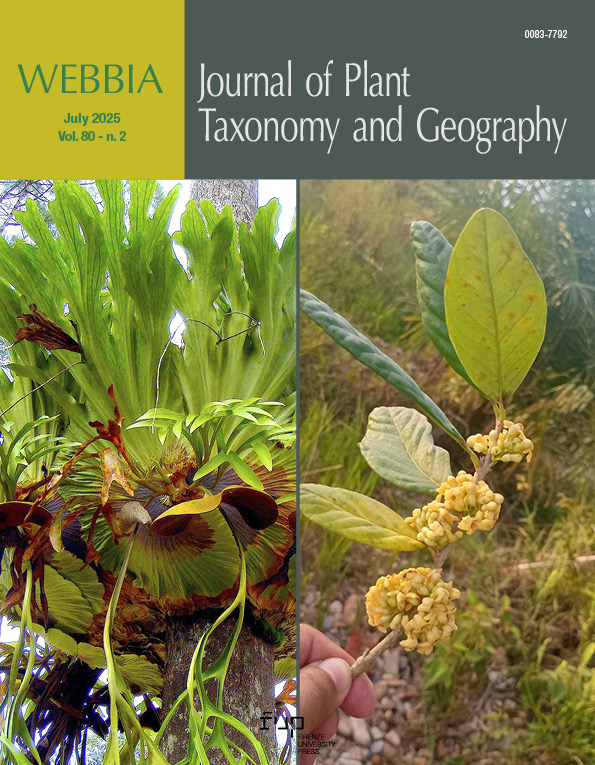New Record of Sarga purpureosericea (Hochst. ex A.Rich.) Spangler (Poaceae) for the Flora of Saudi Arabia and second-step lectotypification of the name
Published 2025-07-18
Keywords
- Andropogoneae,
- lectotype,
- nomenclature,
- Sorghum,
- taxonomy
- Sarga ...More
How to Cite
Copyright (c) 2025 Paulo Alves, Diogo F. Ferreira, José Carlos Brito, Magdy El-Bana, Ahmed Al-Ansari, Omar Al-Attas, Carlos Vila-Viçosa

This work is licensed under a Creative Commons Attribution 4.0 International License.
Abstract
During recent botanical expeditions in the northwestern Saudi Arabia, Sarga purpureosericea Spangler was recorded and collected for the first time in the country. This finding enriches Saudi Arabia’s grass flora and highlights the importance of further botanical exploration. We formally include this species in the national flora, supported by a voucher specimen deposited at the University of Porto Herbarium (PO). This record bridges a significant biogeographical gap between eastern Africa and the Indian subcontinent. Additionally, we provide a second-step lectotypification of the name. The original lectotypification, based on specimens housed at the Kew Herbarium (K) and the Missouri Botanical Garden Herbarium (MO), constitutes a first-step designation under Article 9.17 of the ICN. We now designate a second-step lectotype that aligns more precisely with Spangler’s original intent.
References
- Abulfatih HA. 1992. Range vegetation of the Kingdom of Saudi Arabia. Journal of Arid Environments. 22(1): 23–30.
- Al-Rowaily SL, El-Bana MI, Al-Dujain FAR. 2012. Changes in vegetation composition and diversity in relation to morphometry, soil and grazing on a hyper-arid watershed in the central Saudi Arabia. Catena. 97 (Suppl C): 41–49. https://doi.org/10.1016/j.catena.2012.05.004 DOI: https://doi.org/10.1016/j.catena.2012.05.004
- Al-Rowaily SL, El-Bana MI, Al-Bakre DA, Assaeed AM, Hegazy AK, Ali MB. 2015. Effects of open grazing and livestock exclusion on floristic composition and diversity in natural ecosystem of Western Saudi Arabia. Saudi Journal of Biological Sciences. 22(4): 430–437. https://doi.org/10.1016/j.sjbs.2015.04.012 DOI: https://doi.org/10.1016/j.sjbs.2015.04.012
- Boulos L. 2009. Flora of Egypt: Checklist. Revised edition. Cairo (EG): Al Hadara Publishing.
- Clayton WD. 2008. GrassBase: the online world grass flora. Kew: Royal Botanic Gardens. [accessed 2025 May 10]. http://www.kew.org/data/grasses-db.html
- Contu S. 2013. *Sorghum purpureosericeum*. The IUCN Red List of Threatened Species 2013: e.T44392161A44506411. https://doi.org/10.2305/IUCN.UK.2013-2.RLTS.T44392161A44506411.en DOI: https://doi.org/10.2305/IUCN.UK.2013-2.RLTS.T44392161A44506411.en
- Danin A, Feinbrun-Dothan N 1991. Analytical Flora of Eretz-Israel. CANA Publishing House Ltd., Jerusalem.
- Dumortier BC. 1823. Observations sur les Graminées de la Flore Belgique. Tournai (BE): Casterman. https://doi.org/10.5962/bhl.title.346 DOI: https://doi.org/10.5962/bhl.title.346
- El-Bana MI, Brito JC, Ferreira DF, Coelho AP, Campos J, Al-Ansari A, Al-Attas O. 2025. Terrestrial baseline assessment of the Red Sea Zone: a brief report focusing on key biodiversity areas. Riyadh (SA): Red Sea Global.
- Ewart AJ. 1911. Sarga. In: Ewart AJ, White J, Rees B. (Eds.), Contributions to the flora of Australia. Proceedings of the Royal Society of Victoria. 23(2): 285–304.
- Hosni H, El-Karemy Z. 1993. Systematic revision of Leguminosae in Egypt. 1. *Tephrosia* Pers. Sendtnera. 1:245–257.
- IUCN Standards and Petitions Committee. 2022. Guidelines for using the IUCN Red List categories and criteria. Version 15. Gland (CH): IUCN. https://www.iucnredlist.org/resources/redlistguidelines
- Lamarck, J. (1786). Encyclopédie méthodique: botanique (Vol. 2). chez Panckoucke. https://doi.org/10.5962/bhl.title.824 DOI: https://doi.org/10.5962/bhl.title.824
- Moench, C. (1794). Methodus plantas horti botanici et agri Marburgensis a staminum situ describendi (Vol. 1). Libraria Acad. https://doi.org/10.5962/bhl.title.304 DOI: https://doi.org/10.5962/bhl.title.304
- Moustafa ARA. 2001. Impact of grazing on the vegetation of South Sinai, Egypt. In: Breckle SW, Veste M, Wucherer W (Eds.), Sustainable land use in deserts. Berlin (DE): Springer; p. 218–228. https://doi.org/10.1007/978-3-642-59560-8_22 DOI: https://doi.org/10.1007/978-3-642-59560-8_22
- Nasir E, Ali SI, editors. 1972–1994. Flora of Pakistan. Karachi (PK): Department of Botany, University of Karachi and National Herbarium, NARC.
- POWO. 2025. Plants of the World Online. Facilitated by the Royal Botanic Gardens, Kew. https://powo.science.kew.org/ [accessed 2025 May 19].
- Raizada, MB. (1954). Grasses of the Upper Gangetic Plain and some aspects of their ecology.
- Rivas-Martínez S, Rivas Sáenz S, Penas A. 2011. Worldwide bioclimatic classification system. Global Geobotany. 1: 1–634 + 4 Maps. https://doi.org/10.5616/gg110001 DOI: https://doi.org/10.5616/gg110001
- Snowden JD. 1932. A classification of the cultivated sorghums. Bulletin of miscellaneous information/Royal Botanic Gardens Kew. 1932(5): 221–255. DOI: https://doi.org/10.2307/4107126
- Spangler RE. 2003. Taxonomy of *Sarga*, *Sorghum* and *Vacoparis* (Poaceae: Andropogoneae). Australian Systematic Botany. 16(3): 279–299. https://doi.org/10.1071/SB01006 DOI: https://doi.org/10.1071/SB01006
- Thomas J, Al Khulaidi AW, Al-Qarni M, Hall M. 2021. Towards a Red List of vascular plants of the Arabian Peninsula. Biodiversity and Conservation. 30(13):3663–3684. https://doi.org/10.1007/s10531-021-02242-z
- Turland NJ, Wiersema JH, Barrie FR, Gandhi KN, Gravendyck J, Greuter W, Hawksworth DL, Herendeen PS, Klopper RR, Knapp S, Kusber W-H, Li D-Z, May TW, Monro AM, Prado J, Price MJ, Smith GF, Zamora Señoret JC (Eds.). 2025. International Code of Nomenclature for algae, fungi, and plants (Madrid Code). Chicago (IL): University of Chicago Press.


